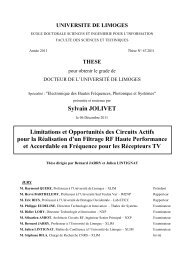Contribution à la conception optimale en terme de linéarité et ...
Contribution à la conception optimale en terme de linéarité et ...
Contribution à la conception optimale en terme de linéarité et ...
You also want an ePaper? Increase the reach of your titles
YUMPU automatically turns print PDFs into web optimized ePapers that Google loves.
CHAPITRE II – CONSIDERATIONS GENERALES SUR LA LINEARITE DES AMPLIFICATEURS DE PUISSANCE<br />
II.4.2.1.2. - Répartition du bruit d’intermodu<strong>la</strong>tion dans <strong>la</strong> ban<strong>de</strong><br />
Dans le cas d’une excitation pour lequel le fonctionnem<strong>en</strong>t du dispositif est faiblem<strong>en</strong>t<br />
non-linéaire, les produits d’intermodu<strong>la</strong>tion d’ordre 3 sont prédominants. La connaissance du<br />
nombre <strong>et</strong> <strong>de</strong> <strong>la</strong> puissance <strong>de</strong> chacun <strong>de</strong>s produits perm<strong>et</strong> <strong>de</strong> calculer <strong>la</strong> répartition du bruit<br />
d’intermodu<strong>la</strong>tion dans <strong>la</strong> ban<strong>de</strong>.<br />
Lorsque le nombre n <strong>de</strong> porteuses augm<strong>en</strong>te les produits d’intermodu<strong>la</strong>tion du type<br />
f1+f2-f sont plus nombreux (variation <strong>en</strong> n 2<br />
3<br />
) <strong>et</strong> plus puissants que les produits<br />
d’intermodu<strong>la</strong>tion du type 2f -f (variation <strong>en</strong> n).<br />
1 2<br />
De plus dans le cas particulier étudié tous les produits d’intermodu<strong>la</strong>tion d’un même<br />
type ont <strong>la</strong> même amplitu<strong>de</strong>.<br />
Il découle <strong>de</strong> ceci que <strong>la</strong> distribution <strong>de</strong>s produits d’intermodu<strong>la</strong>tion t<strong>en</strong>d pour un<br />
) 2<br />
grand nombre <strong>de</strong> porteuses vers ( 3/<br />
8 n au c<strong>en</strong>tre <strong>de</strong> <strong>la</strong> ban<strong>de</strong> (r=n/2) alors qu’<strong>en</strong> bord <strong>de</strong><br />
ban<strong>de</strong> ( r = 0 ou r = n)<br />
leur nombre t<strong>en</strong>d vers n / 4 .<br />
2<br />
⎛<br />
10log⎜<br />
⎜<br />
⎝<br />
La différ<strong>en</strong>ce <strong>de</strong> puissance <strong>en</strong>tre le c<strong>en</strong>tre <strong>et</strong> le bord est donc <strong>de</strong><br />
( 3/<br />
8)<br />
n<br />
2<br />
n<br />
/ 4<br />
2<br />
⎞<br />
⎟ ⎛ 3 ⎞<br />
= 10log⎜<br />
⎟ ≈ 1.<br />
8 dB<br />
⎟<br />
⎠ ⎝ 2 ⎠<br />
n<br />
r<br />
∑ Dn<br />
r = 0<br />
1<br />
Le nombre moy<strong>en</strong> <strong>de</strong> produit dans <strong>la</strong> ban<strong>de</strong> est égale <strong>à</strong> . Ce <strong>terme</strong> est<br />
n<br />
( ) 2<br />
proche <strong>de</strong> 2 / 3 n pour n grand. L’écart <strong>en</strong>tre <strong>la</strong> puissance maximum (au c<strong>en</strong>tre <strong>de</strong> <strong>la</strong> ban<strong>de</strong>)<br />
<strong>et</strong> <strong>la</strong> puissance moy<strong>en</strong>ne vaux<br />
un facteur <strong>de</strong> forme.<br />
D<br />
S<br />
P<br />
⎛ 2 3 ⎞<br />
log⎜ − ⎟ ≈ 0.<br />
53 dB . Ce rapport peut être considéré comme<br />
⎝ 3 8 ⎠<br />
Ban<strong>de</strong> utile du signal<br />
0.53 dB<br />
Fréqu<strong>en</strong>ce<br />
1.8 dB<br />
Puissance moy<strong>en</strong>ne<br />
du bruit<br />
Figure II.4 – D<strong>en</strong>sité spectrale <strong>de</strong> puissance du bruit d’intermodu<strong>la</strong>tion<br />
53
















